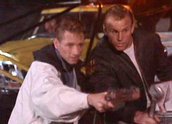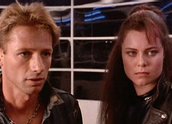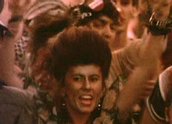


Dead-end Drive-in (1986)
Synopsis
In the 1990s economic and environmental disasters have reduced society to chaos. To combat looting and marauding ‘car boys’, authorities convert the Star Drive-in into a jail for unemployed young people. Captives are given action movies to watch and junk food to live on. Jimmy ‘Crabs’ Rossini (Ned Manning), a naïve young delivery driver, takes his girlfriend Carmen (Natalie McCurry) to the Star, unaware it has become a detention centre. Jimmy is told by the Star’s manager, Thompson (Peter Whitford), that he will remain there until the government decides what to do. Threatened by tough guys Dave (Dave Gibson) and Hazza (Wilbur Wilde), Jimmy’s only hope is to escape over the electrified fence surrounding the complex.
Curator’s notes
In his marvellously good humoured commentary track on the Dead-end Drive-in DVD, Brian Trenchard-Smith accurately sums up the film when he says ‘I enjoy exploring important themes in a wacky way’. A satirical futuristic action film derived from Peter Carey’s short story 'Crabs’ (from The Fat Man in History, 1974), Dead-end Drive-in takes place in a brink-of-apocalypse world similar to Mad Max (1979) and borrows broad elements from the John Carpenter hit Escape from New York (1981), in which Manhattan Island is turned into a maximum security prison. Underpinned by a sharp social and political commentary, Dead-end Drive-in could be considered as a companion piece to Turkey Shoot (1982), Trenchard-Smith’s notorious exploitation shocker, also about life and death in a futuristic prison camp.
With credit to cinematographer Paul Murphy, production designer Larry Eastwood, art director Nick McCallum and costume designer Anthony Jones for the film’s eye-catching graffiti-punk look, Jimmy and the rest of the detainees at the Star Drive-in live in a dysfunctional world created by the greed and immorality of the older, ruling generation. When institutions such as the police are brazenly corrupt (see clip one), why wouldn’t young men become car boys and scrounge violently for whatever they can get?
Once herded into the makeshift prison these rejects create a society that hardly seems much worse than what’s on the other side of the electrified fence. For many of the residents, including chief thugs Frank and Hazza, it’s even better, with a non-stop diet of junk food supplied and drugs readily available. Jimmy, on the other hand, is cut from vastly different cloth. Very well performed by Ned Manning in his only leading role, Jimmy is the classic unbreakable prisoner whose need to bust out of confinement surpasses all other considerations, including romance (see clip three). Pointedly, he’s also the only one who doesn’t show fear and hatred when Asians are dumped at the Star.
An expert at getting the most out of a limited budget, Trenchard-Smith marshals the elements in highly entertaining fashion and comes through with a genuinely awesome finalé. Performed by ace stuntman Guy Norris the climactic sequence set a world record for longest vehicle leap of its kind.
Almost instantly dated by a soundtrack with too many cheesy Aussie synthesiser pop tunes, Dead-end Drive-in did not fare well at the domestic box office, a sign that local audiences still largely believed that Americans did this sort of thing better. But like many Australian action films of the 1970s and ‘80s, it has developed a strong cult following over the years and was highly praised by Quentin Tarantino in the documentary Not Quite Hollywood (2008). Of all the Australian films that attempted to do something interesting in the future-shock arena opened up by Mad Max (1979), Dead-end Drive-in ranks as one of the very best efforts.
Located in Wassell St, the Matraville Drive-in in Sydney’s south-east was demolished soon after it was used for this film. Medium-density public housing now stands in its place.
Dead-end Drive-in was released in Australian cinemas on 18 December 1986.
- Overview
- Curator’s notes
- Video 3 clips
- Principal credits
- Find a copy
- Comments 1
- Map
- Add your review



